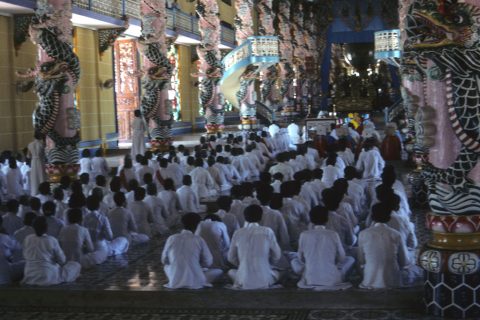
852094800
This elaborate temple at Tay Ninh, located about 60 miles northwest of Ho Chi Minh City, was constructed between 1933 and 1955. The congregation, seen from behind, sits cross-legged on the floor with their hands held up in front of their chests. White robes are worn by lay congregants and solid color robes of red, blue, or yellow are worn by high priests. Cao Dai was created in the 1920s by Vietnamese spiritualists who drew upon, and added to, ideas from the four most influential religious philosophies in Vietnam: Buddhism, Daoism, Confucianism, and Christianity.
Vietnam's new inclusive faith rapidly attracted a national following, so it gradually became perceived as a threat by the French government, the Catholic Church, the Communists, and the South Vietnamese regime. After the North Vietnamese Communists won the Vietnam War in 1975, the Cao Dai religion was heavily persecuted, but it continued underground and spread with those who fled the country to other parts of the world. Since the Vietnamese government agreed to accept it in 1997, it is practiced openly again, with regular ceremonies at the main temple near Ho Chi Minh City.
Most Vietnamese identify themselves as Mahayana Buddhists, but their religious life is replete with popular Chinese and indigenous animist elements. Almost ten percent of Vietnamese identify themselves as Roman Catholics, a legacy of French colonial missions. Cao Dai is now the third most popular religious affiliation in Vietnam with about seven million members. Tens of thousands of Cao Dai followers live in other nations, including the United States.
Creative Commons BY-NC-SA
 852094800
852094800